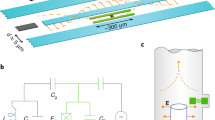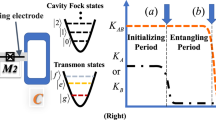Abstract
Electromagnetic signals are always composed of photons, although in the circuit domain those signals are carried as voltages and currents on wires, and the discreteness of the photon's energy is usually not evident. However, by coupling a superconducting quantum bit (qubit) to signals on a microwave transmission line, it is possible to construct an integrated circuit in which the presence or absence of even a single photon can have a dramatic effect. Such a system1 can be described by circuit quantum electrodynamics (QED)—the circuit equivalent of cavity QED, where photons interact with atoms or quantum dots. Previously, circuit QED devices were shown to reach the resonant strong coupling regime, where a single qubit could absorb and re-emit a single photon many times2. Here we report a circuit QED experiment in the strong dispersive limit, a new regime where a single photon has a large effect on the qubit without ever being absorbed. The hallmark of this strong dispersive regime is that the qubit transition energy can be resolved into a separate spectral line for each photon number state of the microwave field. The strength of each line is a measure of the probability of finding the corresponding photon number in the cavity. This effect is used to distinguish between coherent and thermal fields, and could be used to create a photon statistics analyser. As no photons are absorbed by this process, it should be possible to generate non-classical states of light by measurement and perform qubit–photon conditional logic, the basis of a logic bus for a quantum computer.
This is a preview of subscription content, access via your institution
Access options
Subscribe to this journal
Receive 51 print issues and online access
$199.00 per year
only $3.90 per issue
Buy this article
- Purchase on Springer Link
- Instant access to full article PDF
Prices may be subject to local taxes which are calculated during checkout




Similar content being viewed by others
References
Blais, A., Huang, R., Wallraff, A., Girvin, S. & Schoelkopf, R. J. Cavity quantum electrodynamics for superconducting electrical circuits: an architecture for quantum computation. Phys. Rev. A 69, 062320 (2004)
Wallraff, A. et al. Strong coupling of a single photon to a superconducting qubit using circuit quantum electrodynamics. Nature 431, 162 (2004)
Mabuchi, H. & Doherty, A. C. Cavity quantum electrodynamics: Coherence in context. Science 298, 1372–1377 (2002)
Walls, D. F. & Milburn, G. J. Quantum Optics (Springer, Berlin, 2006)
Purcell, E. M. Spontaneous emission probabilities at radio frequencies. Phys. Rev. 69, 681 (1946)
Thompson, R. J., Rempe, G. & Kimble, H. J. Observation of normal-mode splitting for an atom in an optical cavity. Phys. Rev. Lett. 68, 1132–1135 (1992)
Raimond, J. M., Brune, M. & Haroche, S. Manipulating quantum entanglement with atoms and photons in a cavity. Rev. Mod. Phys. 73, 565–582 (2001)
Leibfried, D. et al. Experimental determination of the motional quantum state of a trapped atom. Phys. Rev. Lett. 77, 4281–4285 (1996)
Leibfried, D. et al. Experimental preparation and measurement of quantum states of motion of a trapped atom. J. Mod. Opt. 44, 2485–2505 (1997)
Chiorescu, I. et al. Coherent dynamics of a flux qubit coupled to a harmonic oscillator. Nature 431, 159–162 (2004)
Johansson, J. et al. Vacuum Rabi oscillations in a macroscopic superconducting qubit LC oscillator system. Phys. Rev. Lett. 96, 127006 (2006)
Reithmaier, J. P. et al. Strong coupling in a single quantum dot-semiconductor microcavity system. Nature 432, 197–200 (2004)
Yoshie, T. et al. Vacuum Rabi splitting with a single quantum dot in a photonic crystal nanocavity. Nature 432, 200–203 (2004)
Grangier, P., Levenson, J. A. & Poizat, J. P. Quantum non-demolition measurements in optics. Nature 396, 537–542 (1998)
Caves, C. M., Thorne, K. S., Drever, R. W. P., Sandberg, V. D. & Zimmermann, M. On the measurement of a weak classical force coupled to a quantum-mechanical oscillator. Rev. Mod. Phys. 52, 341–392 (1980)
Wallraff, A. et al. Approaching unit visibility for control of a superconducting qubit with dispersive readout. Phys. Rev. Lett. 95, 060501 (2005)
Brune, M. et al. From Lamb shift to light shifts: vacuum and subphoton cavity fields measured by atomic phase-sensitive detection. Phys. Rev. Lett. 72, 3339–3342 (1994)
Schuster, D. I. et al. AC-Stark shift and dephasing of a superconducting qubit strongly coupled to a cavity field. Phys. Rev. Lett. 94, 123602 (2005)
Brune, M., Haroche, S., Lefevre, V., Raimond, J. M. & Zagury, N. Quantum nondemolition measurement of small photon numbers by Rydberg-atom phase-sensitive detection. Phys. Rev. Lett. 65, 976–979 (1990)
Brune, M. et al. Quantum Rabi oscillation: A direct test of field quantization in a cavity. Phys. Rev. Lett. 76, 1800–1803 (1996)
Nogues, G. et al. Seeing a single photon without destroying it. Nature 400, 239–242 (1999)
Bertet, P. et al. Direct measurement of the Winger function of a one-photon Fock state in a cavity. Phys. Rev. Lett. 89, 200402 (2002)
Bouchiat, V., Vion, D., Joyez, P., Esteve, D. & Devoret, M. H. Quantum coherence with a single Cooper pair. Phys. Scripta T76, 165–170 (1998)
Gambetta, J. et al. Qubit-photon interactions in a cavity: Measurement induced dephasing and number splitting. Phys. Rev. A 74, 042318 (2006)
Irish, E. K. & Schwab, K. Quantum measurement of a coupled nanomechanical resonator-Cooper pair box system. Phys. Rev. B 68, 155311 (2003)
Dykman, M. I. & Krivoglaz, M. A. Profiles of no-phonon lines of impurity centers interacting with local quasilocal vibrations. Sov. Phys. Solid State 29, 210–214 (1987)
Siddiqi, I. et al. Dispersive measurements of superconducting qubit coherence with a fast latching readout. Phys. Rev. B 73, 054510 (2006)
Peil, S. & Gabrielse, G. Observing the quantum limit of an electron cyclotron: QND measurements of quantum jumps between Fock states. Phys. Rev. Lett. 83, 1287–1290 (1999)
Ottl, A., Ritter, S., Kohl, M. & Esslinger, T. Correlations and counting statistics of an atom laser. Phys. Rev. Lett. 95, 090404 (2005)
Monroe, C., Meekhof, D. M., King, B. E., Itano, W. M. & Wineland, D. J. Demonstration of a fundamental quantum logic gate. Phys. Rev. Lett. 75, 4714–4717 (1995)
Acknowledgements
This work was supported in part by the National Security Agency under the Army Research Office, the NSF, the W. M. Keck Foundation and Yale University. A.A.H. acknowledges support from Yale University via a Quantum Information and Mesoscopic Physics Fellowship. A.B. was supported by NSERC, CIAR and FQRNT. Numerical simulations were performed on a RQCHP cluster.
Author information
Authors and Affiliations
Corresponding author
Ethics declarations
Competing interests
Reprints and permissions information is available at www.nature.com/reprints. The authors declare no competing financial interests.
Rights and permissions
About this article
Cite this article
Schuster, D., Houck, A., Schreier, J. et al. Resolving photon number states in a superconducting circuit. Nature 445, 515–518 (2007). https://doi.org/10.1038/nature05461
Received:
Accepted:
Issue Date:
DOI: https://doi.org/10.1038/nature05461
This article is cited by
-
Resolving Fock states near the Kerr-free point of a superconducting resonator
npj Quantum Information (2023)
-
Hole-type superconducting gatemon qubit based on Ge/Si core/shell nanowires
npj Quantum Information (2023)
-
Transmon qubit readout fidelity at the threshold for quantum error correction without a quantum-limited amplifier
npj Quantum Information (2023)
-
A Review of Developments in Superconducting Quantum Processors
Journal of the Indian Institute of Science (2023)
-
Noisy intermediate-scale quantum computers
Frontiers of Physics (2023)
Comments
By submitting a comment you agree to abide by our Terms and Community Guidelines. If you find something abusive or that does not comply with our terms or guidelines please flag it as inappropriate.



